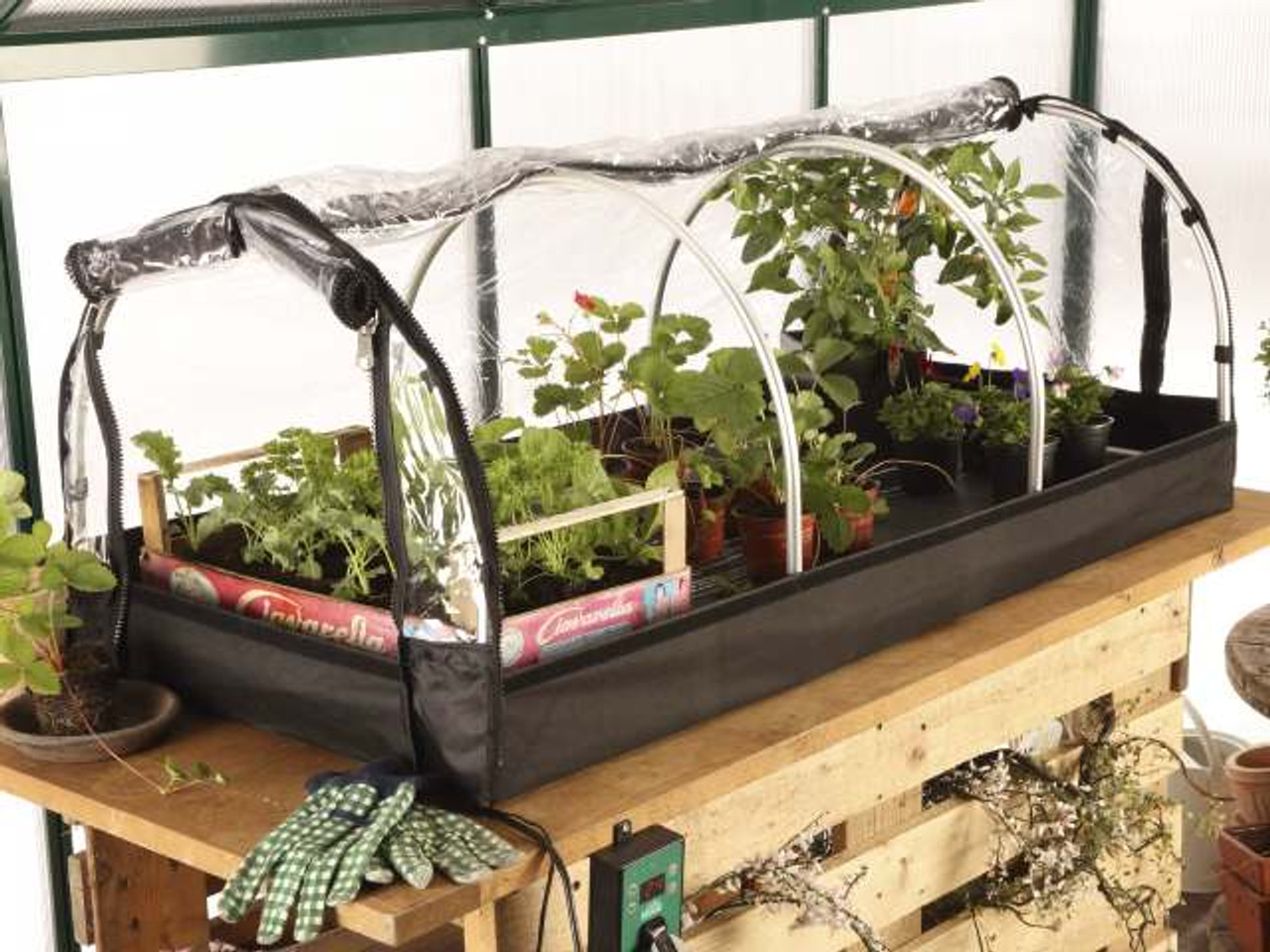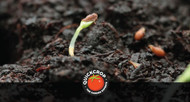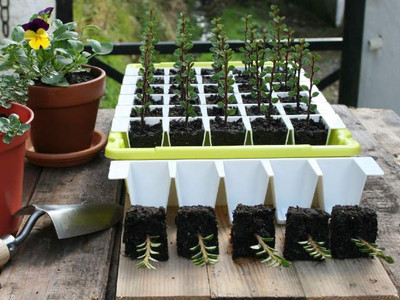The Science of Seed Germination

As you will know if you read last week’s mail, we kicked off our winter plant biology series with roots (I was going from the bottom up), but, in retrospect, I should really have started with seeds. We will correct that error this week as we look at one of the most magical parts of gardening; watching new life unfold from a tiny seed.
There are so many clever ways that plants solve problems, from the simple need for roots to grow down and stems to grow up, to seemingly more complex reactions like roots 'hearing' the sound of running water and growing towards it. It is fascinating, also, how plants go about solving these problems which, naturally enough, are completely different to how animals (or human beings) work.
Today we’ll cover some interesting topics like how a lettuce seed can be turned on or off using red light and, because the same mechanism is involved, how trees can tell the time. This is the headline stuff I guess but, before we get into that, we will look at some basic seed facts so we can establish where our garden plants fit into the bigger picture.

Gymnosperms and Angiosperms
Broadly speaking, the plant kingdom is made up of 5 groups which include seed and non seed producing plants. Plants that don’t produce seeds are lichens (thallophyta), mosses (btyophyta) and ferns (pteridophytes) while the two groups that do produce seeds are conifers (gymnosperms) and flowering plants (angiosperms).
Gymnosperms are by far the oldest (by 200 million years) and are made up of cone producing plants (e.g. conifers or yew trees). Angiosperms cover all flowering plants which means pretty much everything else including grasses, herbs and all the fruit and vegetables that we grow.

Angiosperms are further broken down into two main groups, monocots and dicots. Monocot plants include grasses and bulbs and are relevant to the food grower as they include sweetcorn, asparagus, onions, leeks and grains like wheat or oats. Nearly every other food crop in the vegetable garden will be in the dicot seed group.
The most obvious difference between a monocot and dicot seed is the number of cotyledons that they contain. As usual the clue is in the name as a monocot (or monocotyledon) contains one cotyledon while a dicot (dicotyledon) contains two.

Seed parts
Without getting too bogged down in detail, a seed consists of an embryonic root, shoot and leaves which is connected to a food store. The cotyledons which give monocot and dicot seeds their names transfer nutrients from the seed’s food store (the endosperm) to the growing shoot. In some seeds, e.g. peas and broad beans, the cotyledons are themselves the food store (the two green halves you extract from a peeled broad bean) as well as the transfer mechanism but, either way, they provide the energy for the new root and shoot to grow.
The amount of energy stored in a seed and, therefore, the amount of growth it can support, depends on the size of the seed. This is why sowing depths are important because, if a small seed is sown too deep, it won’t have enough stored energy for the shoot to grow above soil level. Sowing too deep is often the reason for poor germination in very small seeds, particularly in carrots, so it is worth taking note.

Selective weedkillers
Plants produced from a monocot and dicot seed have very different reactions to the hormone auxin (responsible for the tropisms we mentioned last week). This is why auxin based selective lawn weedkiller (aminopyralid or clopyralid) kills broad leaf weeds (dicots) and not the grass which is, of course, a monocot.
I would make the important note that auxin or hormone based weedkillers persist in lawn clippings so, if you have used them, don’t add the clippings to your compost or you will see adverse effects in your crops. Personally I think it is best not to use them at all as contaminated compost or horse manure can wreak havoc in the garden (I speak from experience) and can take more than one season to clear.
Seed germination
Some seeds, like lettuce which we’ll come to in a minute, need light to germinate but for the majority, the requirements are moisture, oxygen and heat. Germination means awaking the seed from its dormant state and triggering the growth of the first root and shoot.
Moisture and Oxygen
Seeds taken from a seed pack should have a moisture content of somewhere between 4 and 12%. The dryness of the seed is one of the factors that stops it germinating which is why we try to store seeds in a cool, dry place.

When the seed is sown in wetted compost, it absorbs water like a sponge which brings moisture content up to between 25 and 50%. This extra moisture triggers enzymes in the seed that begin digesting the food stores and providing energy for the awakened embryo.
The efficient digestion of the food store requires oxygen which is the main reason why seeds sown in compost that is too wet fail; because the water surrounding the seed cuts off the oxygen supply. Remember that until the roots have taken hold and the leaves are open and producing energy, all growth is supported by the food store. If the stored nutrients can't be accessed from lack of oxygen, it is curtains for the seed.

Moisture and dormancy
Some seeds, particularly from woody species, have an inbuilt dormancy which won’t be broken by moisture alone. This is pretty much irrelevant to the vegetable grower but I mention it here because it does apply to woody herbs, e.g. rosemary which is notoriously difficult to germinate.
The reason for dormancy is to prevent the seed from germinating in unfavourable conditions like the cold of winter when the seedling wouldn’t survive. To increase your chances of growing rosemary from seed, you need to fool it into thinking that winter has passed with a process is called ‘Cold Stratification’. This involves folding the seeds in damp kitchen paper, placing them in an unsealed freezer bag and keeping in the fridge for 12 weeks.
The reason this works, if you are interested, is that seeds contain two acids that control germination. Abscisic acid prevents germination while gibberelic acid promotes it. Prolonged exposure to moisture and cold (approx 4˚C) reduces abscisic acid levels and, while they won’t germinate in the fridge (because it is too cold), the seeds should sprout when removed and sown in compost at around 20˚C.

Temperature
I did say that most seeds don’t need light to germinate and, while this is true, the statement could lead to problems because of the relationship between temperature and light. As a rule of thumb, the absolute minimum temperature for germinating seeds in around 5˚C. At this level the germination rate (percentage of the seeds that come up) will be very low. The optimum temperature for germination is between 25 and 30˚ with a maximum of 45 to 48˚ depending on the seed.

Large Vitopod Heated Propagator Single or Double
View ProductI would usually recommend 18˚ for cool climate crops (those that will be planted outside in Ireland and the UK) and 20 to 25˚ for warm climate crops (those that are generally grown in a greenhouse or poly tunnel). That might seem odd as the optimum germination temperatures are higher, so why don’t I increase the heat?

The reason is that, for the bulk of the vegetables we grow, we need to start them off relatively early in the year. This is so we have plants ready to go into the ground when outdoor temperatures have risen in late April or early May. In early spring, not only are daylight hours short, but light intensity is weak because the sun's rays are at a shallower angle and so spread out over a wider area.
The relationship between heat and light is important because the growth of a seedling is partially governed by heat; if there is heat, the seedling will ‘assume’ there is strong sunlight somewhere and grow as fast as it can to find it. Fast growth is weak growth (we will look at why this is the case in the next article on stems) and will produce a tall, thin and weak seedling. We are therefore looking for the lowest efficient germination temperature to try to balance with the lower levels of light.

Bio Green Jumbo Propagator
View ProductIf you are in the habit of germinating seedlings in a hot press or airing cupboard (because it is nice and warm in there), you will know that you have to be on the ball and check them regularly. If you don’t, and they are left in the dark, the new shoots will grow like crazy to find light before the stored energy in their seed is exhausted. So, as soon as seedlings emerge, they need as much light as possible so they can produce energy for themselves (through photosynthesis) and grow at a strong, steady and even pace.

A trick of the light
While most vegetable seeds don’t need light to germinate, there are a number that do including lettuce, celery and celeriac. These seeds should be either sown with the very lightest covering of fine compost or, preferably, not covered at all.
The reason lettuce seeds evolved to require light is that, like poppies, their ancestors were colonisers of disturbed ground. This was likely an adaptation to take advantage of trees falling in a forest which disturbed the ground and allowed sunlight to penetrate to the forest floor. This trait gave a competitive advantage as the seeds could lie dormant and viable for long periods before springing into life when conditions were favourable. This same trait (irritatingly) applies to many garden weeds which lie dormant in the soil but germinate en masse when the soil is disturbed and they are brought to the surface.
Small seeds use light as a trigger to germinate because, as we covered earlier, if planted too deep, their food stores will be exhausted before their shoot breaks ground. Therefore, if the seed can register light, it knows that it is at a shallow enough depth for it's first leaves to make it above ground and get to work.

How does a seed ‘see’ light?
Light sensitive germination is controlled by photoreceptors called phytochromes which change depending on their exposure to light. We’re going down a bit of a rabbit hole here but it is interesting as the action of phytochromes effects plants in many different ways.
Phytochromes act like switches changing from one state to another depending on light conditions. The wavelengths of light absorbed by plants are mostly in the red and blue spectrums (this is why leaves appear green, because the reflect rather than absorb green light) but it is red and far red wavelengths that control germination in light sensitive seeds.

The phytochrome ‘switching’ mechanism works because exposure to either red or far red light changes their state. The two states are referred to as Pr and Pfr (phytochrome red and phytochrome far red); it is Pfr that is the active ‘on’ state while Pr is inactive or ‘off’. Exposure to red light changes Pr (off) to Pfr (on) while exposure to far red wavelengths will reverse the process and change it back again.
But why are red and far red wavelengths relevant? Because direct sunlight contains high intensity red spectrum light while, in the shade, the red has been filtered out leaving mostly far red wavelengths. Therefore, if a seed is exposed to strong red light, it ‘perceives’ sunshine while exposure to far red light signals shade. The advantage to this switching mechanism, of course, is that a seed wants to germinate in sunlight rather than shade so it can use the sun’s energy to grow.

Interestingly, experiments have been done with certain lettuce varieties that show even very brief flashes of red and and far red light can turn the seed on or off. It didn’t matter how many times the switch was triggered as it was the latest flash that determined the state of the seed. If the seed was exposed to a sequence of flashes e.g. Pr - Pfr - Pr - Pfr - Pr - Pfr, the seed would germinate whereas, if the sequence ended in Pr, it wouldn’t.
And finally, just to tie it all together, do you remember our friends from further up the page, abscisic acid (ABA) and gibberellic acid (GA) which prevent or promote germination? These are the same acids that are triggered by the phytochrome switches; Pr releases ABA that prevents germination while Pfr releases GA and promotes it.

How trees know when Autumn has arrived
Well, not quite finally. Now that we understand phytochrome switching, let’s look at a couple of other ways that it works. I don’t know if you have ever wondered how trees know it is time to shed their leaves? What if it is an unseasonably warm Autumn, is leaf fall delayed or is it at the same time every year?
While leaf fall can be initiated by extreme weather events e.g. drought, trees are actually measuring day length (or more accurately hours of darkness) to determine the time of year and, therefore, when to shed their leaves. Again, it is Pr and Pfr switching at work here that allows trees to keep track of time.

In daylight Pr is switched to Pfr but in darkness, Pfr slowly reverts back to Pr at a fixed rate. The fact that Pfr reverts at a predictable rate means there will be more or less of it in the morning depending on how long the night is and, because the amount of Pfr can be ‘measured’ by the tree, the system acts like a clock. If the nights are getting longer (and the days shorter), the amount of Pfr left at sunrise decreases and the tree knows that winter is approaching.
It is also, as it happens, the same two acids ABA and GA that control leaf fall by promoting or retarding growth depending on the levels of Pr and Pfr present. If that’s not all very neat, I don’t know what is.

Annual spinach running to seed
The process by which plants determine day length using Pr and Pfr is known as photoperiodism. As well as controlling leaf fall in deciduous trees, photoperiodism also controls flowering, setting of buds and vegetative growth in the majority of plants.
You will, no doubt, be aware that vegetables like annual spinach or Asian salads always ‘bolt’ or run to seed in summer but behave themselves in the spring or autumn? This is because they are ‘long day’ (or short night) plants and are programmed to flower and produce seed in summer. Of course, you already know what is happening here, your spinach or rocket is measuring the amount of Pfr at dawn and will initiate flowering (using, anyone?, anyone? ... Gibberellic acid) when it senses summer has arrived.
The way around this is to grow long day salads early or late in the season or, in the case of spinach, choose a bolt resistant short day variety for summer crops.




